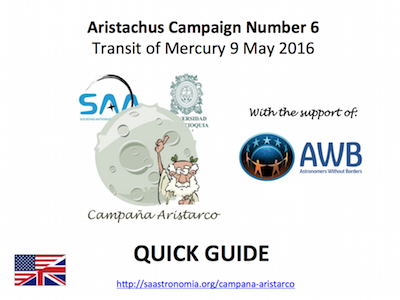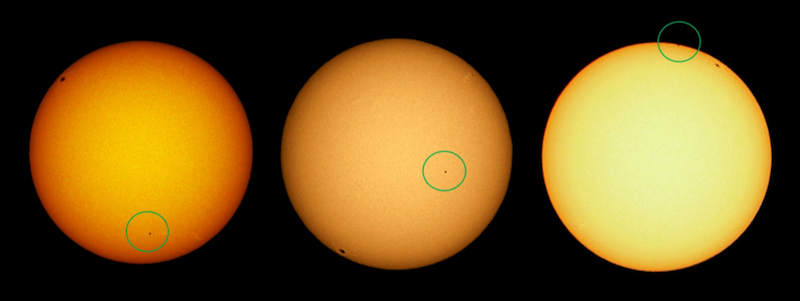
What is the Aristarchus Campaign?
The Aristarchus Campaign is a collaborative experiment (citizen science project) intended to reproduce historical astronomical measurements that allowed astronomers in the past to measure the local Universe using accessible technologies. Today we can also use the same methods but with more precise measurements. Now when almost everyone has a GPS, accurate clocks and internet connection, we can measure the amazing clockwork of our solar system. And you can participate!
If you would like a more in depth training to view the Mercury transit, visit University of Duisburg-Essen's Mercury Transit Project Page.

Consult the quick guide to find out how you can help out.
The Aristarchus Campaign, which has both educational and outreach purposes, is an initiative of the Sociedad Antioqueña de Astronomía (Medellín, Colombia,) the Undergraduate Program in Astronomy of the University of Antioquia and the support of Astronomers Without Borders.
You can find other details about present and past Aristarchus Campaigns in the paper published in 2015 in the Communicating Astronomy to the Public Journal http://bit.ly/aristarchus-capj.
The Mercury Transit of 2016
We would like to invite you to observe the transit of Mercury that will be visible on May 9 2016. As part of our team, we are asking you to perform simple observations that can directly contribute to our understanding of the relationship between Mercury and our Sun. What you will help measure is: the physical size of the planet Mercury, the properties of its orbit around the Sun and the density of our star.
Although these properties have been measured in the past, in this project we will be using information that will be gathered by enthusiastic viewers. The goal of the Aristarchus Campaign is to increase the awareness in the role that citizens could play in helping to gather astronomical observations and assist to “train” an active community of observers for more complex and new observational campaigns.
When will the transit be visible?
The transits of Mercury are astronomical phenomena that last several hours. The May 9 transit for example, will take at least 7.5 hours from the moment when the disk of Mercury "touches” the solar disk to the moment when it exits the opposite side.
The times of each phase of the transit and their characteristics are presented in the table below.
| Phase |
Time (UTC-5) |
Conditions |
Transit Stars
Contact 1 |
6:13:34 am |
AP 9:15*
Solar elevation 6 degrees |
Ingress ends
Contact 2 |
6:16:46 am |
Ingress duration: ~3min |
| Maximum Transit |
9:57:54 am |
AP 7:00
Solar elevations 59 degrees
Distance to solar centre: 17%** |
Egress starts
Contact 3 |
1:38:11 pm |
Egress duration: ~3min
Solar elevation 63 degrees |
Transit ends
Contact 4 |
1:41:22 pm |
AP 4:30 |
|
* AP is “o'clock” position of Mercury with respect to the north pole of the solar disk. AP 12:00 corresponds to the North point of the solar disk, AP 3:00 corresponds to the west point, AP 6:00 is the South, etc.
** The distance of Mercury to the center of the solar disk is measured in terms of the solar diameter. Thus, 17% corresponds to approximately one fifth of the solar disk diameter.
|
Times of the Transit are calculated for New York City. Times are in EST or UTC-5 however times vary by only several seconds in North America whereas for other regions in the world they differ by less than one minute. To calculate the exact time for your city check out the Mercury Transit Calculator: http://bit.ly/aristarco6-tiempos-transito
The times of the transit for other timezones can be calculated by adding or subtracting the difference with UTC-5. The transit will be visible from those places in the world where the Sun is above the horizon (daytime) at the time of the phenomenon. In some places, e.g. the U.S. east coast or western Europe, the transit will be visible entirely from the time Mercury enters the disk of the sun to exit or ingress to egress. Others will be able to observe just a fraction of the transit. As long as you can see part of the transit, you can participate!
You can check the map below to see if you will be able to see this fascinating sight. (** See: http://eclipsewise.com/oh/tm2016.html - please give credit to the site)
How to get prepared to participate in the Campaign?
In order to participate in this Aristarchus Campaign you will need a smartphone with GPS, a telescope or a camera equipped with a telephoto lens. You will also need a solar filter (VERY IMPORTANT!!!) to protect your eyes and equipment against the powerful rays of the sun.
Mercury is very small compared to the Sun which makes very difficult to observe the transit with the naked eye (using for instance mylar/solar eclipse glasses) or simple cameras. To see the small planet passing in front of our star you need to magnify the image of the Sun.
**PLEASE NOTE: It it VERY dangerous to view the sun without the use of a solar filter to both your eyes and your electronic equipment. The sun will produce permanent damage to your eyes or destroy the electronic sensors of your camera.
For more information about how to view the sun safely, please refer to the following web pages:
http://www.mreclipse.com/Totality2/TotalityCh11.html
http://eclipse.gsfc.nasa.gov/SEhelp/safety2.html
Observations:
In order for us to be able to use your observations, we will need to get your precise GEOGRAPHIC POSITION of the observing site. You can obtain this information with the GPS that is integrated in most smartphones. We will not only need latitude and longitude (with at least 5 decimal places) but also the altitude above the sea level. Make sure that you are outside when you collect the GPS coodinates to get a precise position, no further than 10 meters from where you’ll be taking your photos. Wait a few minutes until the cellphone receives information from as many GPS satellites as possible before recording the coordinates. This will ensure that the precision of your data required for advanced astronomical observations. Please no not use Google Earth to obtain your position as it is grossly inaccurate.

We will also need the precise TIME when the pictures are taken with uncertainties of less than a second. For that purpose you can set the clock of your camera or cellphone using an online service such as http://www.time.gov. Even if the clock of your equipment is properly set, the best way to ensure that we know the precise time when the pictures is to capture the screen of a computer showing the official time.
Example of a picture taken of the screen of a computer with the official time using the same equipment that was used to register the transit.
What should I observe?
Many astronomical measurements can be recorded during a planetary transit, some of them can be simple and others very complex. Astronomers in the past used these phenomena to determine the size of the Solar System and measure the properties of the interior planets.
For this particular transit the only thing that you need to do is to take pictures of the solar disk where Mercury be visible in at least three different times during the transit. Of course feel free to take more than 3 images and share them with us.
In order to be useful for the Campaign, the images should be separated by tens of minutes (half an hour, one hour, etc.). An example of submitted images are shown in the figure below.

Example of the pictures we need for the Aristarchus Campaign. As illustrated here, the three submitted images can have arbitrary orientations (notice the position of the sunspot in the three images). The only condition is that they be taken in the same place. Credit: Mila Zinkova and Pasachoff et al.
Simple, eh? So get out and OBSERVE!
What's next?
Once you have taken the pictures share them with us. Fill out the form on this page and upload your photos!
or Email: [email protected]
You can also use a Cloud Sharing service such as Dropbox or WeTransfer etc. Just let us know where to find your data!
Please DO NOT modify the images before sending them to us! We need the pictures such as they are stored in the camera including its metadata (information about the time when the pictures where taken and other properties of the instruments).
You must also submit the unmodified picture (or pictures) of the screen showing the official time.
What will we do with your pictures?
Once all the images are collected, a group of physics and astronomy students, professional astronomers and volunteer enthusiasts, will analyze them images and calculate astronomical data as astronomers did in the past.
In particular for this transit we would like to measure the properties of Mercury’s Orbit (size, eccentricity and orientation in space) as it has the strangest orbit among the 8 known planets in the Solar System. These methods are similar to those that astronomers use to study the movements or orbits of planets outside of our solar system which includes the physical size of the planet and the solar density and mass.
With very simple measurements, we can obtain incredible knowledge collected by an enthusiastic amateur astronomer like you.
If we can collect enough valuable data out team will be able to write a scientific report and publish it in a peer review journal which will be shared on the website http://arxiv.org.
If you want to participate in the scientific analysis or if you have collected particularly important observations, you can be a coauthor of the report as other enthusiasts have been in the past.
Take a look at other scientific reports from previous Aristarchus Campaigns that have already been published: http://saastronomia.org/campana-aristarco.
Once the report is published all the information and data will be freely available.









